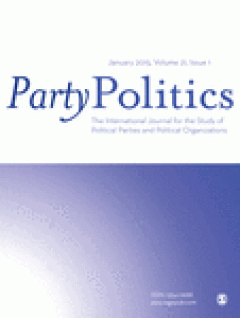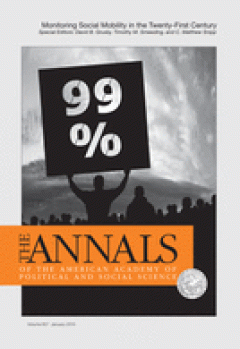Filter by

Preference for radical right-wing populist parties among exclusive-nationalis…
The literature on authoritarianism and exclusive forms of nationalism often implies that authoritarian and exclusive-nationalist individuals will prefer radical right-wing populist parties such as Austria's FPÖ. The theoretical case for such implications appears sound as party programmes for radical right-wing populist parties invoke rhetoric that should appeal to individuals with either of the…
- Edition
- Volume 21, Number 3 May 2015, pages 367-380
- ISBN/ISSN
- 1354-0688
- Collation
- -
- Series Title
- Party Politics
- Call Number
- -

Hard acts to follow Predecessor effects on party leader survival
In this article, using our original data on party leadership succession in 23 parliamentary democracies, we investigate the determinants of a party leader’s survival rate: how long he/she remains in office. Unlike previous studies, which focus on institutional settings of leadership selection or on situational (political, economic and international) conditions at the time of succession, we prop…
- Edition
- Volume 21, Number 3 May 2015, pages 357-366
- ISBN/ISSN
- 1354-0688
- Collation
- -
- Series Title
- Party Politics
- Call Number
- -

Economic accountability and strategic calibration The case of Japan’s Libe…
I argue that the Liberal Democratic Party (LDP) of Japan employed a strategy to prevent unpopular prime ministers from tainting the party’s image. Time-series analyses of public opinion data from 1960 to 2006 show that national economic performance had modest effects on prime minister support ratings and no effects on LDP ratings. When prime minister ratings fall below party ratings, cabinets a…
- Edition
- Volume 21, Number 3 May 2015, pages 346-356
- ISBN/ISSN
- 1354-0688
- Collation
- -
- Series Title
- Party Politics
- Call Number
- -

The personalization of politics in Australia
While national election campaigns have become increasingly personalized, it is unclear to what extent this trend has been replicated at the constituency level. Using surveys of Australian election candidates conducted from 1996 to 2010, this article tests the personalization hypothesis at the local constituency level. Three areas that may be affected by personalization are examined: constituenc…
- Edition
- Volume 21, Number 3 May 2015, pages 337-345
- ISBN/ISSN
- 1354-0688
- Collation
- -
- Series Title
- Party Politics
- Call Number
- -

When does the left do the right thing? A study of party position change on we…
Why did pro-welfare Social Democrats and Christian Democrats cease to support the welfare state in the 1980s and 1990s, and support measures such as tighter welfare programme conditionality rules and lower social security benefits instead? Building on the party position change literature, I argue and empirically demonstrate that parties with an activist-dominated party organization adapt their …
- Edition
- Volume 21, Number 1 January 2015, pages 54-67
- ISBN/ISSN
- 1354-0688
- Collation
- -
- Series Title
- Party Politics
- Call Number
- -

Lobbying and Policy Change: who wins, who loses and why
- Edition
- -
- ISBN/ISSN
- 978-0-226-03944-2
- Collation
- xiv, 341p.; 23 cm
- Series Title
- -
- Call Number
- 320.6 BAU l
- Edition
- -
- ISBN/ISSN
- 978-0-226-03944-2
- Collation
- xiv, 341p.; 23 cm
- Series Title
- -
- Call Number
- 320.6 BAU l

The good, the bad and the voter The impact of hate speech prosecution of a p…
Hate speech prosecution of politicians is a common phenomenon in established democracies. Examples of politicians tried for hate speech include Nick Griffin in Britain and Jean-Marie Le Pen in France. Does hate speech prosecution of politicians affect the electoral support for their party? This is an important question, as the parties involved typically are controversial, often accused of stirr…
- Edition
- Volume 21, Number 1 January 2015, pages 100-114
- ISBN/ISSN
- 1354-0688
- Collation
- -
- Series Title
- Party Politics
- Call Number
- -

Issues and leaders as vote determinants The case of Italy
A growing literature highlights the importance of leader image as a determinant of voting in contemporary democracies and as a force now paralleling the explanatory power of traditional structural and ideological factors affecting voting choice. Yet the actual effect of leaders in the citizen’s vote calculus remains uncertain because of the potential reciprocal causation between leader evaluati…
- Edition
- Volume 21, Number 2 March 2015, pages 272-283
- ISBN/ISSN
- 1354-0688
- Collation
- -
- Series Title
- Party Politics
- Call Number
- -

Horizontal accountability during political transition The use of deputy requ…
Horizontal accountability, in which institutional actors with equivalent levels of authority possess tools to challenge one another, is a critical component of mature and stable democracy. This article investigates ways in which partisanship differentiates how political actors use a specific accountability tool – legislative questions – and the responsiveness of government institutions to inqui…
- Edition
- Volume 21, Number 1 January 2015, pages 115-131
- ISBN/ISSN
- 1354-0688
- Collation
- -
- Series Title
- Party Politics
- Call Number
- -

Gentrification in Changing Cities: Immigration, New Diversity, and Racial Ine…
This article examines how the rise of immigration and its associated racial and ethnic changes relate to gentrification. In the decades following the 1965 Hart-Celler Act, gentrification has occurred more in cities with high levels of immigration and in neighborhoods with higher levels of immigrants. These relationships, however, vary by the ways in which a city is racially segregated and by th…
- Edition
- Volume 660, July 2015, pages 319-340
- ISBN/ISSN
- 978-1-5063-2455-5
- Collation
- -
- Series Title
- THE ANNALS OF THE AMERICAN ACADEMY OF POLITICAL AND SOCIAL SCIENCE
- Call Number
- -

EPAC – a new dataset on ethnonationalism in party competition in 22 Europea…
Datasets in the field of ethnic politics still tend to treat ethnonational groups as unitary actors and do not differentiate between the positions of the organizations representing these groups. Datasets in the field of party politics differentiate between the positions of political parties, yet fail convincingly to conceptualize an ethnonational dimension of competition. This Research Note pre…
- Edition
- Volume 21, Number 1 January 2015, pages 153-160
- ISBN/ISSN
- 1354-0688
- Collation
- -
- Series Title
- Party Politics
- Call Number
- -

The influence of electoral institutions on legislative representation Eviden…
This study aims to offer empirical evidence of how electoral systems influence the way legislators represent their constituencies. In particular, it analyses the influence of electoral systems on legislators’ representations in terms of a pattern of policy areas represented by them. By comparing legislators’ behaviour under Japan’s multi-member district, single non-transferable vote and single-…
- Edition
- Volume 21, Number 2 March 2015, pages 209-221
- ISBN/ISSN
- 1354-0688
- Collation
- -
- Series Title
- Party Politics
- Call Number
- -

Electoral systems and the Sheriff of Nottingham Determinants of disproportio…
Abundant research provides evidence that electoral systems have an impact on party system fragmentation. Taking up these findings, and adopting a dynamic approach, this article explores the effect of electoral refoms on electoral disproportionality. Specifically, it demonstrates that permissive changes in the electoral system improve the overall correspondence between vote-shares and seat-share…
- Edition
- Volume 21, Number 2 March 2015, pages 222-233
- ISBN/ISSN
- 1354-0688
- Collation
- -
- Series Title
- Party Politics
- Call Number
- -

The political economy of party building Theory and evidence from Peru’s in…
This article theorizes the strategies used by parties to expand their support base, with a particular focus on the allocation of party goods. Here, we theorize that nascent parties with goods to hand out will favour a particular type of societal group, which we name private-gain-seeking groups. We utilize Peru’s party system collapse following Fujimori’s rule as an opportunity to test our hypot…
- Edition
- Volume 21, Number 2 March 2015, pages 169-182
- ISBN/ISSN
- 1354-0688
- Collation
- -
- Series Title
- THE ANNALS
- Call Number
- -

Party change, social media and the rise of ‘citizen-initiated’ campaigning
This article argues that digital media are introducing a new grassroots-based mode of ‘citizen-initiated campaigning’ (CIC) that challenges the dominant professionalized model of campaign management by devolving power over core tasks to the grassroots. After defining the practice through reference to the 2008 campaign of Barack Obama and online parties literature, we devise a measure of CIC tha…
- Edition
- Volume 21, Number 2 March 2015, pages 183-197
- ISBN/ISSN
- 1354-0688
- Collation
- -
- Series Title
- PARTY POLITICS
- Call Number
- -

Brave rebels stay home Assessing the effect of intra-party ideological heter…
Sanctions and homogeneity of intra-party preferences are the two main pathways to party unity in roll-call votes. However, only a few works have managed to properly measure the degree of polarization within the party, and therefore the link between ideological preferences and parliamentary voting behaviour has not yet been fully tested. Looking at the internal debates held during party congress…
- Edition
- Volume 21, Number 2 March 2015, pages 246-258
- ISBN/ISSN
- 1354-0688
- Collation
- -
- Series Title
- Party Politics
- Call Number
- -

The niche party concept and its measurement
The concept of the niche party has become increasingly popular in analyses of party competition. Yet, existing approaches vary in their definitions and their measurement approaches. We propose using a minimal definition that allows us to compare political parties in terms of their ‘nicheness’. We argue that the conceptual core of the niche party concept is based on issue emphasis and that a nic…
- Edition
- Volume 21, Number 2 March 2015, pages 259-271
- ISBN/ISSN
- 1354-0688
- Collation
- -
- Series Title
- Party Politics
- Call Number
- -

Using MP statements to explain voting behaviour in the German Bundestag An i…
Why do members of parliament (MPs) vote against the party line? Recent explanations of party unity focus on MPs cross-pressured between the demands of competing principals such as their party and local constituencies. This article tests key claims of the Competing Principals Theory on the level of individual deputies. It relies on public statements in which MPs explain their voting behaviour. T…
- Edition
- Volume 21, Number 2 March 2015, pages 284-294
- ISBN/ISSN
- 1354-0688
- Collation
- -
- Series Title
- Party Politics
- Call Number
- -

Party registration rules and party systems in Latin America
Existing studies have paid a great deal of attention to how electoral systems affect party politics, but there has been little discussion in the literature on the effects of party registration rules. The theoretical importance of the impact of party registration rules on party system development lies in its temporal priority to the effects of electoral systems. This study aims to fill the theor…
- Edition
- Volume 21, Number 2 March 2015, pages 295-308
- ISBN/ISSN
- 1354-0688
- Collation
- -
- Series Title
- Party Politics
- Call Number
- -

Measuring parties’ ethnic appeals in democracies
Unlike existing approaches to the study of ethnic politics, this article argues that the political competition for ethnic votes in modern democracies is programmatic (i.e. distinguishable by its focus on issues and policies), much like the competition for voting blocs defined as based on class or gender. Analysing ethnic appeals in this manner makes them suitable for the type of quantification …
- Edition
- Volume 21, Number 2 March 2015, pages 309-327
- ISBN/ISSN
- 1354-0688
- Collation
- -
- Series Title
- Party Politics
- Call Number
- -
 Computer Science, Information & General Works
Computer Science, Information & General Works  Philosophy & Psychology
Philosophy & Psychology  Religion
Religion  Social Sciences
Social Sciences  Language
Language  Pure Science
Pure Science  Applied Sciences
Applied Sciences  Art & Recreation
Art & Recreation  Literature
Literature  History & Geography
History & Geography